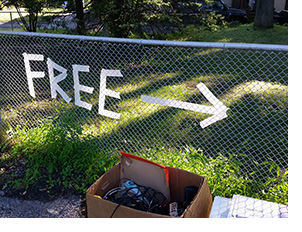Reducing Waste by Swapping with Friends & Neighbors
Thrift stores have been around for more than 100 years. In this fascinating article about the history of thrift stores on Time.com, thrift stores in the U.S. started with Salvation Army’s “salvage brigade” launched in 1897 out of the basement of a men’s shelter. Residents went around the neighborhood with pushcarts asking for used clothes, and they got food and lodging in return. A Methodist minister launched Goodwill, a similar operation, in Boston in 1902.
During the 20th century, thrift stores were the most common place for people to donated unwanted clothing and goods. They were also a place people went to shop for low-cost items. Thrift store buyers are not just the poor. Shoppers come from all walks of life and many love the thrill of finding hidden gems or high-value collector’s pieces like a work of art from Jackson Pollock.
According to an IBISWorld, thrift stores are part of a $14.4 billion industry. While this is a huge market, people are finding new ways to get rid of their old stuff or find needed items. Prior to Facebook, it was garage sales, children’s consignment events and Craig’s List. Sustainability-focused campus groups frequently host pop-up swap shops, especially for Halloween costume swaps and move-in/move-out days.
On Facebook, people have created local online garage sale groups, groups meant for people giving away things for free, crop swap groups and more. With the increase of these groups, swapping has become easy. Swapping with friends, family and neighbors is a great way to reduce waste and keep things out of landfill. You never know who might need something that you no longer have use for.
As someone who does a lot of swapping, here are some things I have swapped or witness being swapped:
- Costumes: My daughter needed a pirate costume for a theme day at summer camp. I posted on a Facebook group and within an hour, I had secured a pirate costume from a neighbor who pulled it out of her donation bag. Another neighbor was looking for a sombrero for her daughter’s Halloween costume, and I gave her one I had no use for anymore. I also learned that there is a huge need for costumes for children in foster care. A social worker posted she would love any donated costumes for kids in foster care and she received dozens of donations.
- Diapers: I foster dogs and a dog came to me in heat. I bought a pack of diapers for the dog to wear but after cutting tail holes in two diapers, I realized my plan wasn’t going to work. The rest of the pack of diapers went to someone who needed them for an actual baby. People frequently try out new diapers, realize they don’t like them and give the rest of the pack away.
- Produce: My basil plants were big and beautiful this summer. I could not keep up with how much I had. I invited neighbors to clip my plants and also brought to work to share with my co-workers. I’ve also shared store-bought produce I wasn’t going to use with friends and co-workers. A woman fostering guinea pigs, asked for lettuce and other produce people weren’t going to use for her animals. I had unused romaine so I gave it to her. (Rabbit rescues will also take produce!) As a fan of model and author, Chrissy Teigen, I recently tried to find a new home for my brown bananas. She once asked fans on social media if they had any. I didn’t find a home for my three brown bananas this time, but I connected with two neighbors who said they like to bake and would take my brown bananas in the future. By the way, did you know bananas and lettuce are two of the most wasted produce item?
- Books and magazines: I have three Little Free Libraries in my neighborhood. I donate books there or donate them to my kids’ school. Cookbooks are great for sharing and swapping. I couldn’t wait for a library hold to come up on a new cookbook so I bought it and now share with the rest of the team at Eco Promotional Products. My mom reads magazines and then gives them to me when she’s done. When I’m done, I either leave them at the gym for others to enjoy or give them to a neighbor who collects them for the senior home where she works.
- Clothes: I’ve been given hand-me-downs and I donate my unwanted clothes to others.
- Stationery, crafts and party supplies: These items are not the best for donating to thrift stores. But people love swapping gift bags, stationery, arts and crafts supplies, party decorations, classroom supplies and the list goes on.
The next time you find something you no longer have use for try finding a new home for it. You’ll be surprised at what people will happily take off your hands.



